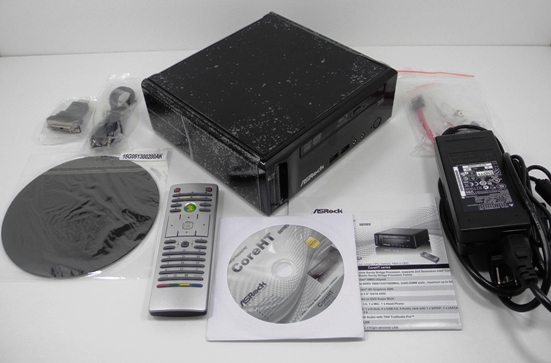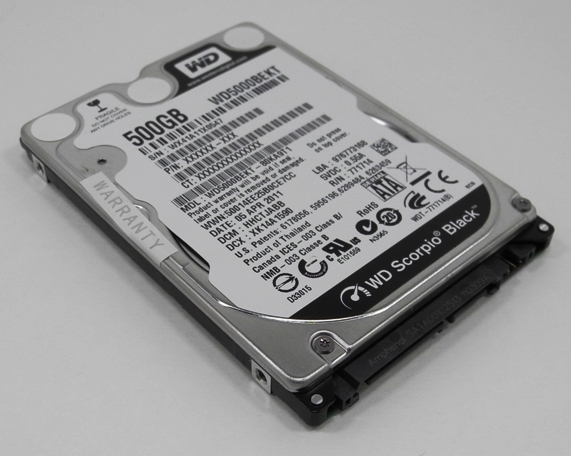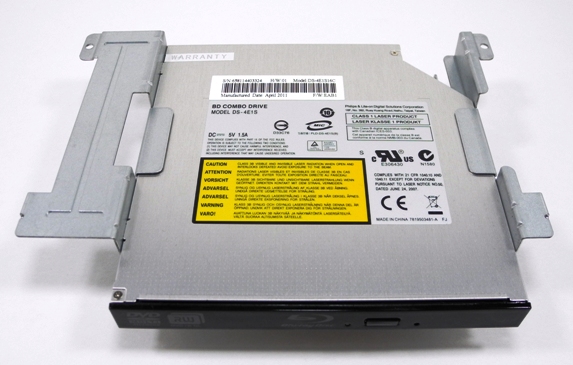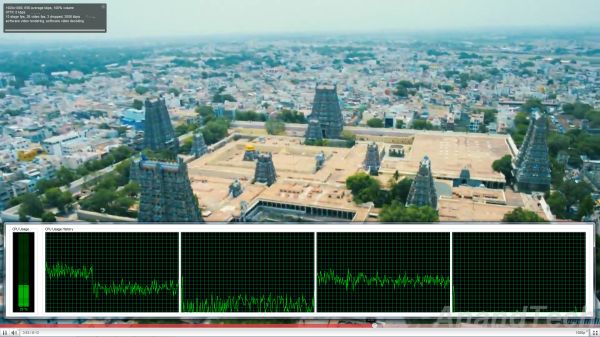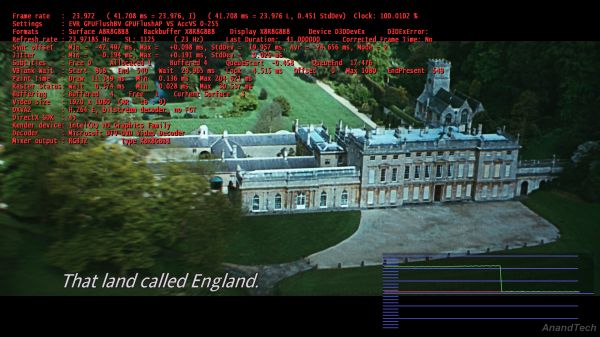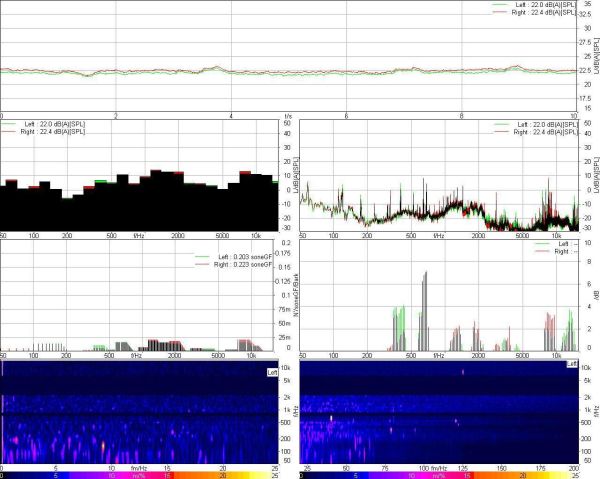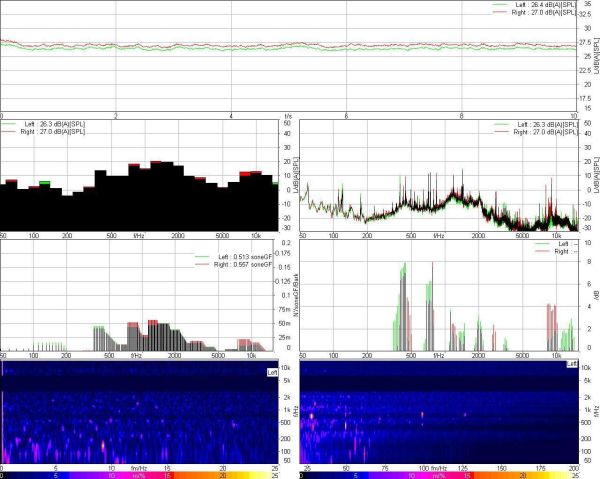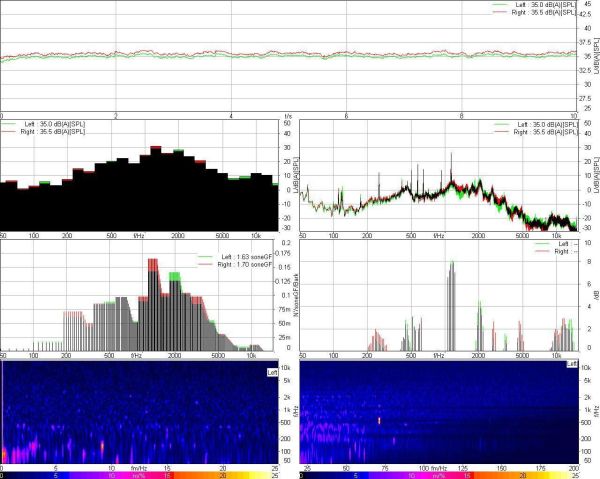
Original Link: https://www.anandtech.com/show/4713/asrock-coreht-252b-review
ASRock CoreHT 252B Review
by Ganesh T S on September 2, 2011 3:45 AM EST- Posted in
- Intel
- ASRock
- Media Streamer
- HTPC
The small form factor (SFF) HTPC market has been steadily growing over the last few years. As mobile processors become more and more powerful, it is becoming easier for users to be satisfied with their performance even in desktop configurations.
The DIY HTPC crowd has a marked preference for mini-ITX motherboards and cases. However, the excessive TDP of desktop CPUs resulted in complicated thermal designs and noisy results. Thermal designs for systems with mobile CPUs with 35W TDPs are fairly straightforward and not very noisy. In fact, it is even possible to create systems which are fully passively cooled.
ASRock has three HTPC families catering to the entry level, mid-range and high-end markets. While the ION based HTPCs form the entry level, the Core series serves the mid-range and the Vision series caters to the high-end. Today, we will be looking in detail at the CoreHT 252B, the second generation Core series HTPC from ASRock. First off, let us take a look at the configuration of the review unit sent to us by ASRock
| ASRock CoreHT 252B HTPC Specifications | |
| Processor |
Intel Sandy Bridge Core i5-2520M (2 x 2.50 GHz (3.20 GHz Turbo), 32nm, 3MB L2, 35W) |
| Chipset | Intel HM65 |
| Memory | 2 x 2GB DDR3-1333 |
| Graphics |
Intel HD Graphics 3000 650 MHz / 1.3 GHz (Turbo) |
| Hard Drive(s) |
500GB 7200RPM 2.5" HDD (Western Digital Scorpio Black WD5000BEKT) |
| Optical Drive | Blu-ray/DVDRW Combo |
| Networking |
Gigabit Ethernet 802.11b/g/n (2T2R Atheros AR5B97 in AzureWave AW-NE121H mini-PCIE card) |
| Audio |
Microphone and headphone/speaker jacks Capable of 5.1/7.1 digital output with HD audio bitstreaming (optical SPDIF/HDMI) |
| Operating System | Windows 7 Home Premium 64-bit (Retail unit is barebones) |
| Extras |
THX TruStudio Pro Audio Certification IR receiver and MCE remote |
| Pricing | TBD |
ASRock has three configurations of the CoreHT series available. Two of them have the Core i3-2310M processor (one with a Blu-ray drive - CoreHT 231B, and the other with a DVD drive - CoreHT 231D). The review unit is the CoreHT 252B with the Core i5-2520M processor. This comes with a Blu-ray drive.
The ASRock CoreHT 252B package contained the following:
- Main unit in a 2.5L chassis (195mm x 186mm x 70mm)
- 90W AC / DC adapter
- Media Center remote with batteries
- Support CD with drivers and miscellaneous software
- HDMI - DVI dongle
- SATA and power cables / screws for user installation of second hard disk
- 3.5mm audio cable
- Anti-slip base pad for the main unit
The industrial design is nothing to write home about. The pleasing rounded edges are reserved for the higher end Vision series. The CoreHT series has to make do with a sharp edged chassis very similar to the first generation Core 100HT.
When compared with the Core 100 from last year, we find that two of the USB 2.0 ports at the rear end of the unit become USB 3.0 ports in the CoreHT. The front panel remains the same except for the structure of the ventilation slot which is now curved in (instead of the planar slots in the Core 100) and the shape of the power button is now circular instead of the square in the last generation unit.

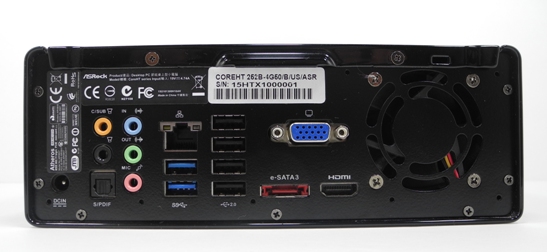
Just like a notebook, this unit also supports simultaneous display on two monitors. Testing was done mostly with the HDMI output connected to a Toshiba REGZA 37" 1080p TV through an Onkyo TX-SR 606. For non-media playing related testing, the HDMI port was connected to an Acer H243H 1080p monitor.
Our review unit shipped with Windows 7 x64 Ultimate and a OEM version of Cyberlink PowerDVD for Blu-Ray playback. However, the OEM version doesn't support 3D Blu-rays and is also crippled with respect to the number of audio channels that can be decoded / HD audio passthrough. To test these, we installed the full versions of both Cyberlink PowerDVD 11 as well as ArcSoft Total Media Theater 5.
We will conclude this section with a table to summarize the data and A/V connectivity options for the ASRock CoreHT 252B HTPC.
| Option | Status |
|---|---|
| HDMI | Yes [v1.4a] |
| Component | No |
| Composite | No |
| VGA | Yes |
| SPDIF | Yes [Optical] |
| Stereo |
Yes |
Data Connectivity Options for the ASRock CoreHT 252B
| Option | Status |
|---|---|
| Optical Disk Drive | Yes [Blu-Ray / DVD-RW] |
| USB | Yes [4 x v2.0, 4 x v3.0] |
| eSATA | Yes [1 x v3] |
| LAN | Yes [ 1000 Mbps GbE ] |
| Internal HDD | Yes [ 500 GB ] |
| WiFi | Yes [ 300 Mbps 2T2R 802.11n ] |
| Card Reader | No |
The ASRock CoreHT 252B is primarily built out of notebook components, and it is not possible for the average enthusiast to build such a system with off-the-shelf components.
Motherboard & Chipset : mini-ITX Intel HM65
The motherboard used in the CoreHT series is based on the Cougar Point Intel HM65 chipset. The CoreHT server series uses the HM67 chipset, and we will take a look at that unit in another review. ASrock's mini-ITX motherboard used in the CoreHT 252B is the HM65-HT. The 2 SATA 6 Gbps ports are available as headers on the motherboard, while one SATA 3 Gbps port is made available as an eSATA3 port. Another SATA port is available as a header on the motherboard (it is connected to the Blu-ray drive).
The mini PCI-E slot is taken up by the Atheros based AzureWave WLAN module. The two sides of the CoreHT chassis are used as antennae. The two DIMM slots are on the right side of the board, next to the CPU.

CPU : Intel Core i5-2520M
The Core i5-2520M is a 35W TDP processor belonging to the 32nm Intel Sandy Bridge family. Clocking in at 2.50 GHz, it is capable of going up to 3.2 GHz for a single core and 3.0 GHz for both the cores in turbo mode. 3MB of Intel Smart Cache is shared between the two cores and the integrated GPU.
GPU : Intel HD Graphics 3000
The integrated GPU in the Sandy Bridge processors come in two varieties, namely, HD Graphics 2000 and HD Graphics 3000. The Core i5-2520M uses the latter. It has a base frequency of 650 MHz, and is capable of going up to 1.3 GHz in stressful conditions.
It supports full 3D video capabilities, QuickSync and WiDi. However, WiDi is not supported by the CoreHT 252B. WiDi makes sense for laptops, but not much for SFF HTPCs. So, we don't fault ASRock for avoiding this feature.
DRAM : ASInt 2 x 2GB DDR3-1333
ASRock has used a relatively new memory vendor in ASInt for the CoreHT 252B. The memory chips operate with a 9-9-9 CAS latency.
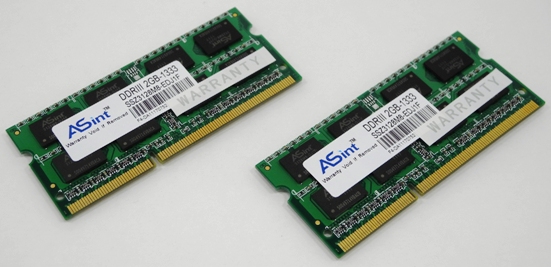
Hard Disk : Western Digital Scorpio Black 500GB 7200 rpm 2.5"
The 500GB Scorpio Black is one of the best reviewed hard disks in its class. It has been reviewed to have upto 120 MBps sequential read speeds.
The hard disk is a good choice with respect to the price - performance ratio for the ASRock CoreHT 252B.
Optical Disk Drive : Philips Lite-on Blu-ray / DVD RW Tray Loading Drive
The ASRock CoreHT 252B ships with the Philips Lite-on DS-4E1S BD Combo Drive.
We would have liked a slot loading model, but ASRock reserves that for the high end Vision series. The slot loading model has a considerable cost premium, so we are not really complaining.
MCE Remote
One of the shortcomings of the ASRock HTPCs when compared with something like the Zinos from Dell is the absence of a wireless keyboard / mouse combo. However, ASRock does take care to ensure the presence of an IR receiver in the system and also bundle a MCE remote.
Compared to the MCE remote used in the Core 100, we see a step up. The remote bundled with the unit is the same as the one bundled with the Vision 3D.
Unfortunately, the quality of the MCE remote is a big letdown. The keys are quite small and the unit feels cheap in the hand despite being pretty decent in appearance.
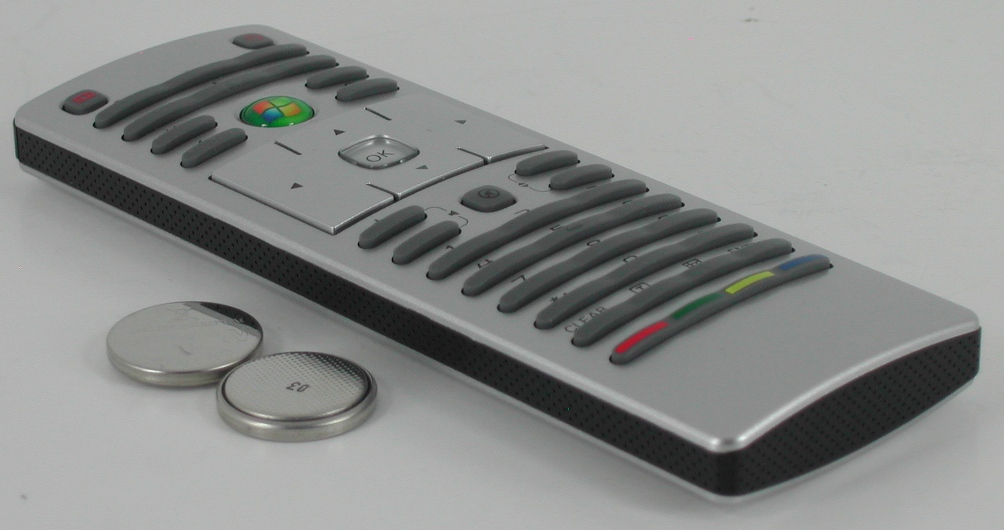
In the next few sections, we will take a look at the performance of the ASRock CoreHT 252B.
The ASRock CoreHT 252B is basically a notebook solution. It wouldn't make sense to compare it with full blown desktop Sandy Bridge solutions (or for that matter, any system with a power consumption of more than 100W). In the comparative benchmarks provided in the rest of this review, we will provide the scores obtained by the CoreHT 252B and other similar SFF HTPC solutions.
Windows Experience Index
This metric is often considered meaningless, but we feel it serves as an indicator of what could be the bottleneck in a system for pre-built HTPCs. Surprisingly, it is not the HD 3000 GPU which is responsible for the score of the system. Both the RAM and the hard disk weigh in at 5.9.

The Core i5-2520M supports DDR3-1600 for its DRAM. ASRock could have used the higher speed DRAM and / or a SSD as the primary disk in order to improve this score.
USB 3.0 Performance
The first generation Core 100 HTPC couldn't provide full USB 3.0 performance due to limitations in the HM55 chipset. Compared to the 6 PCI-Express ports in the HM55 chipset, we have 8 in the HM65. This makes it possible for the USB 3.0 controllers to provide full performance.
The CoreHT 252B provides four USB 3.0 ports, two at the front and two at the rear. Renesas (NEC) continues to provide the USB 3.0 controllers for ASRock's mid-range HTPCs. We hooked up OCZ's Enyo 128 GB USB 3.0 external SSD (which has received glowing reviews everywhere with upto 200 MBps read and 190 MBps write speeds) to the various USB 3.0 ports of the CoreHT 252B. Using the Random Access feature of HD Tune Pro 4.50, we obtained the average read and write speeds for random sized accesses to random locations on the SSD. The performance metrics are graphed below.
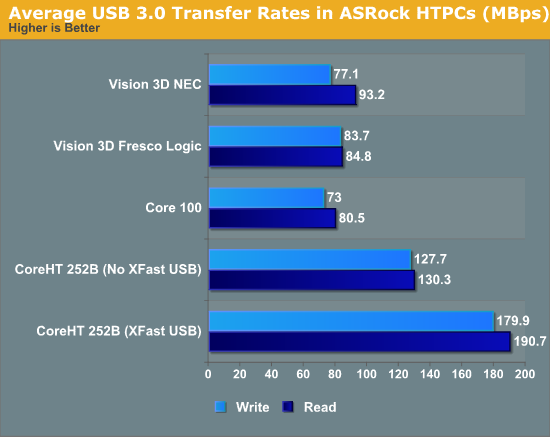
At the outset, it is clear that the USB 3.0 performance improves drastically over the Core 100 and the Vision 3D. ASRock supplies XFast USB, a driver level feature to improve USB performance. As is evident from the above graph, disabling XFast USB seems to have a huge detrimental effect on the performance. In any case, it is advisable for the users to keep XFast USB enabled to get the best out of their system.
Miscellaneous Performance Metrics
The graphs below give an idea of where the ASRock CoreHT 252B stands with respect to performance when compared with other SFF HTPCs. PCMark Vantage's PCMark score gives a general idea of the system's capability.
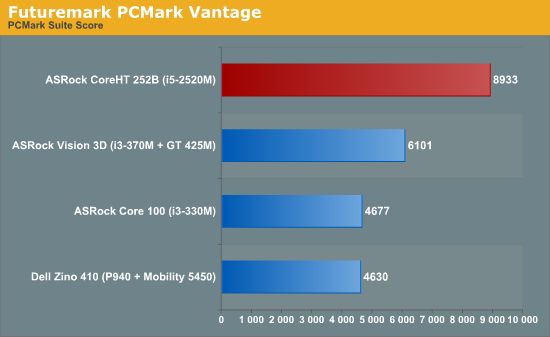
We also ran the 3D Mark Vantage and 3D Mark 06 benchmarks and the graphs below show how the Intel HD Graphics 3000 fares when compared to the GPU capabilities of other pre-built SFF HTPCs.
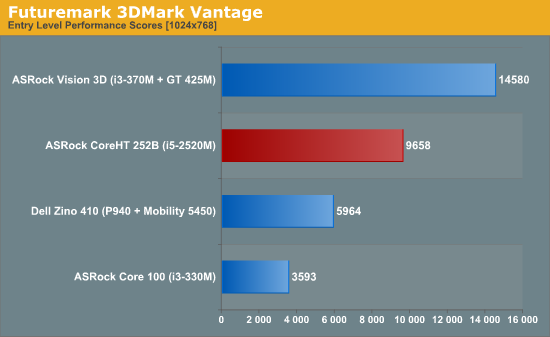
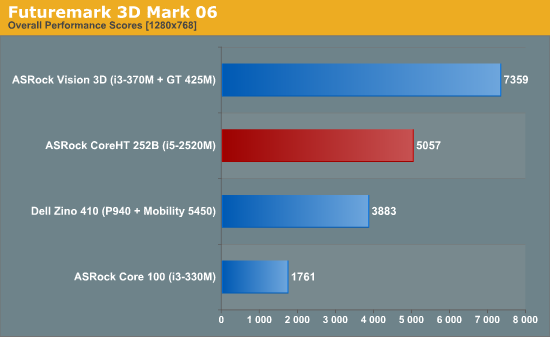
Intel HD Graphics 3000 manages to beat the Mobility 5450 easily in the synthetic benchmarks. In terms of the PC-centric scores, the CoreHT is miles ahead of the SFF HTPCs from last year. This goes on to prove that the bar for the mid-range HTPC just keeps getting higher.
In addition to the above synthetic benchmarks, a couple of commong HTPC workloads were also benchmarked. We have some data on the x264 encoding performance using the i5-2520M. Note that we are unable to utilize QuickSync for this test because QuickSync is unable to provide any for of support for accelerating x264 encode.
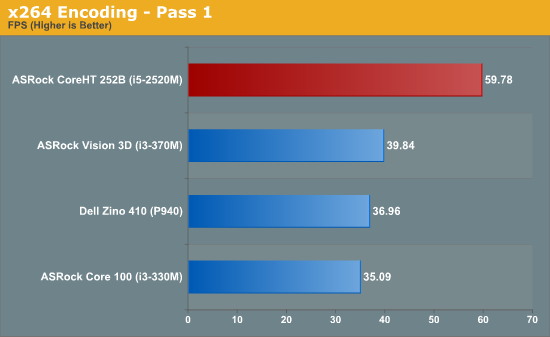
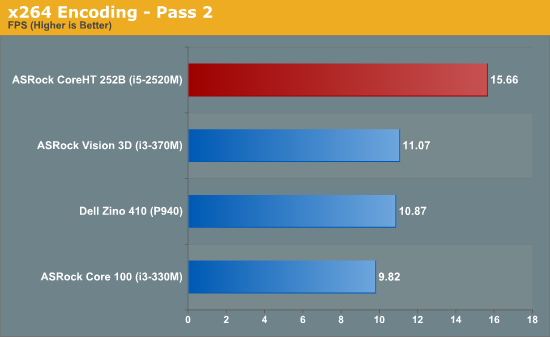
An estimate of how well WinRAR performs, particularly with respect to processing split archives, wraps up this section. To evaluate this, we take a 4.36 GB MKV file, compress it in the 'Best' compression mode into a split archive (97.1 MB each), which results in 44 files on the hard disk. The time taken to decompress this split archive is then recorded. The performance in this benchmark is heavily influenced by the hard disk in the system. It looks like both the CoreHT 252B and the Vision 3D are close to the best possible results in this benchmark, thanks to their 7200 rpm disk.
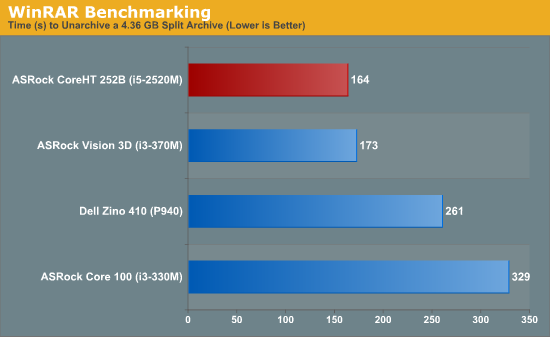
We have deliberately refrained from dealing with gaming benchmarks in this review. Serious gaming enthusiasts know that Intel's integrated GPU is not going to pass muster. For readers interested in finding out how good Intel's HD Graphics 3000 fares in our gaming benchmark, I would suggest looking at Jarred's review of the Asus K53E, which houses a i5-2520M and 6 GB RAM (compared with the i5-2520M and 4GB RAM of the CoreHT 252B that we are dealing with here).
The ASRock CoreHT 252B is covered quite nicely with respect to networking hardware. With support for both Gigabit Ethernet and 802.11n, it really doesn't matter if you keep the unit beyond cable reach from the router. All our network streaming tests were carried out with a 300 Mbps 802.11n network (currently provided in my lab location by a RT-N16 802.11n gigabit router from Asus). We were easily able to stream HD clips of more than 50 Mbps. HD YouTube videos and HD Netflix streaming had no issues.
While on the topic of network streaming, let us take a brief look at how the system performs while accessing online video services. We used Flash 10.3 in Firefox 4 with Intel Graphics Driver v2372 for testing. The first set of screenshots below show the CPU usage while playing back a 1080p YouTube video with and without hardware acceleration enabled. This is the same clip used in all the other SFF HTPC reviews.
1080p YouTube HD Streaming without Hardware Acceleration
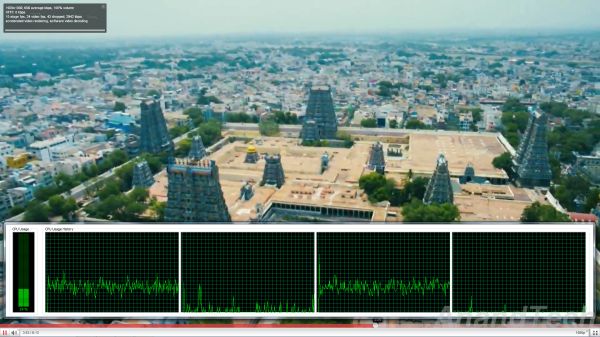
1080p YouTube HD Streaming with Hardware Acceleration (Flash in Firefox)
Unfortunately, enabling hardware acceleration in the Flash properties seems to result in only accelerated video rendering. The decode still ends up being done in software. This accounts for the ~5% decrease in CPU usage when hardware acceleration is enabled. Just before posting the review, we also confirmed that the issue still exists on IE9 / Firefox 6.0 with Flash 10.3.183.7. Another puzzling aspect was the fact that we could get hardware accelerated decoding for some videos occasionally.
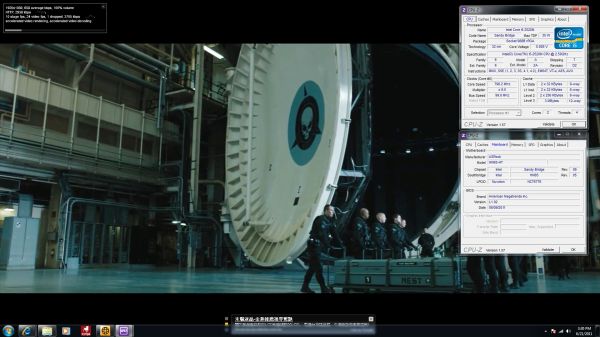
1080p YouTube HD Streaming with Hardware Acceleration (Flash in IE9)
It looks like the Adobe Flash Player has some trouble in hooking up to the Intel DXVA library. Both AMD and NVIDIA platforms support GPU acceleration for Flash without issues. It is disappointing to note that the largest GPU vendor (in terms of install base) still hasn't got this working right.
Netflix streaming, on the other hand, uses Microsoft's Silverlight technology. Unlike Flash, hardware acceleration for the video decode process is not controlled by the user. It is upto the server side code to attempt GPU acceleration. Thankfully, Netflix does try to take advantage of the GPU's capabilities. This is evident from the A/V stats recorded while streaming a Netflix HD video at the maximum possible bitrate of 3.8 Mbps. While the video is definitely not 1080p, we observe that the CPU utilization of around 18% is lower than the CPU usage for a 1080p YouTube video.
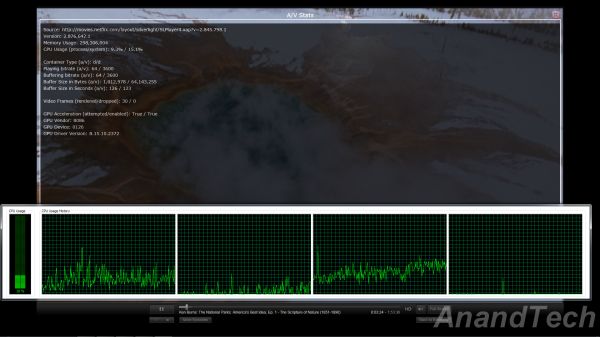
Netflix HD Streaming with Hardware Acceleration
Users of media streamers streaming online videos often have to put up with messages of the sort 'This content is not available on TV connected devices' or need to queue up the videos on a PC before accessing them through their media streamer box. HTPC users don't need to worry about any such limitations.
On a side note, it is disappointing to see Netflix restrict its 1080p / DD+ 5.1 offerings to the PS3 and Roku 2. It is the PC platform which launched the streaming business for Netflix. It would be good if they do not relegate HTPC users to being second string consumers as their popularity grows.
HTPC enthusiasts are often concerned about the quality of pictures output by the system. While this is a very subjective metric, we have decided to take as much of an objective approach as possible. Starting with the Core 100 review last year, we have been using the HQV 2.0 benchmark for this purpose.
The HQV 2.0 test suite consists of 39 different streams divided into 4 different classes. The playback device is assigned scores for each, depending on how well it plays the stream. Each test was repeated multiple times to ensure that the correct score was assigned. The scoring details are available in the testing guide on the HQV website.
In the table below, we indicate the maximum score possible for each test, and how much the ASRock CoreHT 252B was able to get. As mentioned in the previous section, we used Intel Graphics Driver v2372 for the benchmarking.
| HQV 2.0 Benchmark | ||||
| Test Class | Chapter | Tests | Max. Score | ASRock CoreHT 252B (Intel HD3000) |
| Video Conversion | Video Resolution | Dial | 5 | 5 |
| Dial with Static Pattern | 5 | 5 | ||
| Gray Bars | 5 | 5 | ||
| Violin | 5 | 5 | ||
| Film Resolution | Stadium 2:2 | 5 | 5 | |
| Stadium 3:2 | 5 | 5 | ||
| Overlay On Film | Horizontal Text Scroll | 5 | 3 | |
| Vertical Text Scroll | 5 | 5 | ||
| Cadence Response Time | Transition to 3:2 Lock | 5 | 5 | |
| Transition to 2:2 Lock | 5 | 5 | ||
| Multi-Cadence | 2:2:2:4 24 FPS DVCam Video | 5 | 5 | |
| 2:3:3:2 24 FPS DVCam Video | 5 | 5 | ||
| 3:2:3:2:2 24 FPS Vari-Speed | 5 | 5 | ||
| 5:5 12 FPS Animation | 5 | 5 | ||
| 6:4 12 FPS Animation | 5 | 5 | ||
| 8:7 8 FPS Animation | 5 | 5 | ||
| Color Upsampling Errors | Interlace Chroma Problem (ICP) | 5 | 2 | |
| Chroma Upsampling Error (CUE) | 5 | 2 | ||
| Noise and Artifact Reduction | Random Noise | SailBoat | 5 | 5 |
| Flower | 5 | 5 | ||
| Sunrise | 5 | 5 | ||
| Harbour Night | 5 | 5 | ||
| Compression Artifacts | Scrolling Text | 5 | 3 | |
| Roller Coaster | 5 | 3 | ||
| Ferris Wheel | 5 | 3 | ||
| Bridge Traffic | 5 | 3 | ||
| Upscaled Compression Artifacts | Text Pattern | 5 | 3 | |
| Roller Coaster | 5 | 3 | ||
| Ferris Wheel | 5 | 3 | ||
| Bridge Traffic | 5 | 3 | ||
| Image Scaling and Enhancements | Scaling and Filtering | Luminance Frequency Bands | 5 | 5 |
| Chrominance Frequency Bands | 5 | 5 | ||
| Vanishing Text | 5 | 5 | ||
| Resolution Enhancement | Brook, Mountain, Flower, Hair, Wood | 15 | 15 | |
| Video Conversion | Contrast Enhancement | Theme Park | 5 | 5 |
| Driftwood | 5 | 5 | ||
| Beach at Dusk | 5 | 2 | ||
| White and Black Cats | 5 | 5 | ||
| Skin Tone Correction | Skin Tones | 10 | 3 | |
| Total Score | 210 | 176 | ||
This table is almost the same as the one we presented in the Llano review. The only difference is that the HD 3000 now gets some points for skin tone correction. While AMD and NVIDIA tend to correct the skin tones and make the picture appear better as the strength of the correction is increased (move away from default), Intel seems to work best at the default setting. Experimenting with the strength of the skin tone correction makes the image quality much worse than either AMD's or NVIDIA's at any setting.
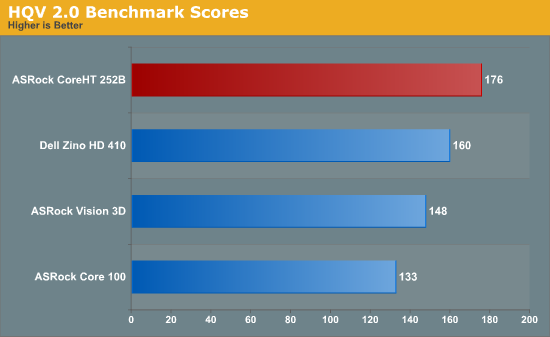
It is heartening to see that there is a big jump in performance for Intel's integrated graphics with respect to the HQV scores. While the Core 100 turned up with a sub-140 score last year, we see the CoreHT 252B rising above what AMD and NVIDIA's entry level GPUs achieve.
Does this improved HQV score actually lead to better picture quality in general? What about other HTPC video aspects? We will cover these in the next two sections.
One of the main issues with Intel's integrated GPU solutions for HTPC users was the absence of 23.976 Hz refresh rate support. When Sandy Bridge was launched, it was discovered that the 23 Hz setting could be activated and made to function as intended if UAC was disabled. With v2372 drivers, the disabling of UAC became unnecessary.
While we don't get perfect 23.976 Hz yet, it is definitely much better than the earlier scenario. Though there are user reports of lip sync still being an issue (particularly when used with a projector), we were unable to corroborate this finding. Personally, I managed to watch two complete movies at their native refresh rate without losing lip sync in our test setup.
23.976 fps Video Playback (MPC-HC/EVR-CP) with 23Hz Refresh Rate Setting
24 fps Video Playback (MPC-HC/EVR-CP) with 24Hz Refresh Rate Setting
The 24 Hz refresh rate feature works as before. Unfortunately, the drifting in the refresh rates doesn't seem to average to 23.976 Hz in the first case. The player locks to 23.972 fps, which implies a skipped frame every 250s (~4 minutes). The scenario seems similar for other refresh rates.
Another aspect we found irritating with Intel's GPU control panel is the custom resolution section. Intel seems very reliant on EDID and doesn't allow the user to input any frequency not supported by the display. I recently got hold of a display (Sony KDL46EX720) to help test 3D as well as multiple refresh rates. Since the unit was sold in the US, it doesn't indicate PAL compatibility in its EDID information. I was able to play back PAL videos with matched refresh rates using the Vision 3D (NVIDIA GT 425M), but Intel's control panel wouldn't allow me to set up 50 Hz as the display refresh rate. It is possible that an EDID override might help, but we can't help complaining about Intel's control panel not being as user friendly as NVIDIA's.
In the next section, we will look at how the integrated GPU in the ASRock CoreHT 252B handles cadence detection and deinterlacing.
Video post processing aspects such as skin tone correction and denoising are part of the HQV 2.0 benchmark. However, it is cadence detection which forms a major part of the tested aspects. Deinterlacing is closely tied with cadence detection. Although deinterlacing, by itself, is not stressed in the HQV 2.0 benchmark, it is very important for the end users.
In contrast to the performance of the Core 100, the CoreHT 252B manages to ace all the HQV 2.0 cadence detection tests.
 |
|
| CoreHT 252B | Vision 3D |
Edge Adaptive Deinterlacing Test Stream from the Spears & Munsil Test Disc
In this stream which tests edge adaptive deinterlacing, there is actually nothing to choose inbetween the GT 425M and the Intel HD Graphics 3000. The nature of the ropes around the sail is almost exactly the same. Before moving on to the next section, we have to note that the AMD Radeons remain the GPUs to beat when it comes to deinterlacing quality.
The ASRock CoreHT 252B scored full marks in our streamer test suite. However, this was not without extensive tinkering around with respect to codecs and splitters. One of the irksome issues with respect to Intel HD Graphics is that the drivers do not play well with the open source DXVA video decoders. Because of this, the native MPC Video Decoder and XBMC's DXVA2 acceleration are simply unusable on Intel GPU based systems.
In this section, I will outline the steps taken to get a working stable-XBMC-build based setup on a CoreHT 252B running Windows 7. The aim of this section is to get the following:
- Retain XBMC UI for navigation and playback as much as possible
- Play Blu-ray ISOs and discs through XBMC
- Get hardware acceleration for all possible video codecs
- Utilize bitstreaming capability for HD audio
- Match display refresh rate to video frame rate
Achieving the above requires the following mix of open source and commercial software:
- ArcSoft Total Media Theater 5 with the checkactivate.dll hack (from Step 2 in this post).
- Virtual CloneDrive
- Latest stable build of MPC-HC
- Latest version of LAV Filters
- Latest stable version of XBMC
Since Intel's GPU drivers don't work properly with XBMC's native DXVA acceleration, we are forced to use MPC-HC as an external player. However, MPC-HC's default DXVA codecs also don't work. I have also found that the internal splitters of MPC-HC are not as bug-free as the LAV Splitter.
Setting up MPC-HC
- Install LAV Splitter and accept all the default settings
- Install LAV Audio Decoder and configure the codecs you want to bitstream
-
Install MPC-HC and import the registry settings available here, which will configure MPC-HC as follows (in order)
- Prefer Microsoft DTV-DVD Decoder (for MPEG-2 and H.264 DXVA acceleration)
- Prefer ArcSoft Video Decoder (for both progressive and interlaced VC-1 DXVA decode)
- Prefer LAV Splitter
- Prefer LAV Audio Decoder
- The corresponding internal filters are obviously disabled
- Note that the registry settings don't set the auto refresh rate feature. Fiddle around with the MPC-HC settings in a manner suitable for your setup.
After the above steps, you should be able to get any media file (H.264 / MPEG-2 / VC-1) to play back properly through MPC-HC.
Configuring Blu-ray Playback
Assuming that Virtual CloneDrive and ArcSoft TMT5 are installed in the default locations, you will just need to extract the batch files in the For_XBMC folder inside the archive here. The For_XBMC folder can be extracted to, say, C:\For_XBMC. The latest build of ArcSoft TMT5 already has auto refresh rate enabled.
The next step is to get XBMC to use these external players.
Using MPC-HC and ArcSoft TMT5 inside XBMC
XBMC's software decode works very well for Real Media, MPEG-4 and other streams for which GPU decode acceleration is not available. After installing XBMC, we need to place the playercorefactory.xml (part of the archive here in "C:\Users\${UserName}\AppData\Roaming\XBMC\userdata". Alternatively, you could just back up the original playercorefactory.xml in "C:\Program Files (x86)\XBMC\system" (assuming you are the only XBMC user in the system) and replace it with the downloaded XML file.
There are lots of resources online about this topic . Of particular relevance to the setup described above are this AVForums post and this AVSForum post.
With the above setup, you should be able to stream videos and watch Blu-ray discs and ISOs without leaving the XBMC UI. The only downside is that you lose the fancy Video OSD during playback, but that is the price you will need to pay with an Intel GPU based system if you want hardware decode and stable HD audio bitstreaming from within XBMC right now.
HTPC enthusiasts are rightly concerned about the noise factor, heat and power consumption, ease of usage and many other criteria. We will tackle each of these concerns one by one in this section.
Noise
ASRock doesn't make any claims about the quietness of the system in their marketing material. We were pleasantly surprised upon looking at the noise reports. In the set of pictures below, a professional sound level detector was placed less than 2 ft away from the CoreHT, and the sound level measurements were taken in various HTPC scenarios. The unit has a noise level of less than 36 dB at full load (for both CPU and GPU). In this respect, it is actually similar in performance to the earlier SFF HTPCs from ASRock.
22.4 dB at Idle
27 dB during Disc Playback
35.5 dB at Full Load (Prime95 + Furmark)
Power Consumption
In order to get an idea of the power consumption numbers, the Prime95 and Furmark benchmarks were let run overnight to keep both the CPU and GPU completely loaded for an extended duration. Under these extreme conditions, we found the average power consumption to be around 62.8 W. At idle, the average power consumption was around 18 W.
These type of power consumption numbers have been enabled by ASRock's choice of going in for a notebook platform instead of a desktop configuration. This has resulted in a smaller form factor case design for the mini-ITX motherboard. Since there is not much heat to be dissipated, the cooling system is also appropriately small and silent.
Ease of Use
HTPC enthusiasts are concerned about how easy it is for their system to come out of standby. Existence of HDMI handshake issues upon return from standby is also a deal breaker for many. Fortunately, the CoreHT 252B has no issues in these two aspects. As long as the AC power adapter is connected to the system, the bundled MCE remote can be used to boot the system (even if the PC had been shut down previously). In order to shorten the boot times, ASRock supplies an Instant Boot utility. Using this, whenver the CoreHT is shut down, it boots up once again and shuts down before the power can be safely removed. Upon power up, the boot up is instantaneous. The MCE remote can also be used to bring the PC out of sleep mode.
Power users can also take advantage of the AXTU (ASRock eXtreme Tune Up) utility for greater overclocking control.
Within Windows, the MCE remote can be made to work with a variety of applications such as XBMC, MediaPortal, MPC-HC and of course, Windows 7 Media Center. Blu Ray players such as PowerDVD and ArcSoft TMT can also be controlled with the help of the MCE remote. For the ideal I/O scenario, one probably needs to purchase a wireless keyboard / mouse combo.
The CoreHT 252B represents a quantum leap in both CPU and HTPC related GPU prowess over the Core 100. As such, we have no hesitation in recommending the CoreHT if the Core 100 was ever in your radar. Of course, pricing is an important aspect. We are assuming that this mid-range HTPC will debut around the same price with which the Core 100 was launched.
Our recommendation, however, doesn't come without reservations. Both ASRock and Intel have areas in which they can improve. Throughout the review, we have covered the positive aspects of the CoreHT 252B.
In this concluding section, we will identify aspects which can be improved.
ASRock:
- The performance of the HTPC could have been improved by using a SSD for the boot drive. ASRock indicates that a second 2.5" hard drive can be attached to the underside of the ODD/HDD chassis. It should be pretty straightforward to use a 32 GB SSD as the second drive without having an exorbitant rise in the unit's price.
- The supplied MCE remote is basically a marketing checklist item. Instead of that, a mini wireless keyboard / touchpad combo would have also made up for the lack of a wireless keyboard and mouse in the package.
- Minor industrial design updates to make the chassis more attractive would be nice. For example, the ASRock logo could be shifted to the lid and even made bigger in the process. Similarly, the power LED can also be shifted to the lid (similar to what is in the Zino HD 410)
Intel:
- Intel's DXVA implementation is a very big mess for all the open source DXVA decoders (MPC Video Decoder and XBMC's DXVA2 implementation). Intel should step in and work with the developers to make sure those decoders work perfectly with the Intel GPUs. Intel GPU based system purchasers are forced to shell out more money for commercial decoders in order to get the benefit of reliable hardware acceleration even for local file playback.
- It is not possible to get hardware acceleration for decode as well as madVR rendering with Intel GPUs and open source / freeware decoders. Intel's GPU shaders are also not powerful enough for consistent madVR. We hope that the GPU in Ivy Bridge will be powerful enough for madVR so that we can contemplate running some benchmarks for that.
- Needless to say, the video post processing algorithms can use some improvements to get to the quality provided by the AMD and NVIDIA GPUs.
- Intel needs to make the custom resolution feature user friendly (at least as good as NVIDIA's). It must not be restricted by the EDID from the display (for the advanced users, at least)
Despite the above issues, we were able to configure the HTPC to serve the average user well. As that is the intended goal of this mid-range HTPC, we have to say that ASRock has succeeded in putting out a capable successor to the Core 100.

